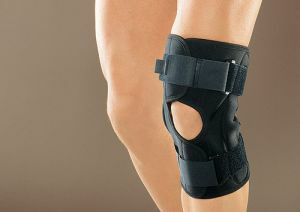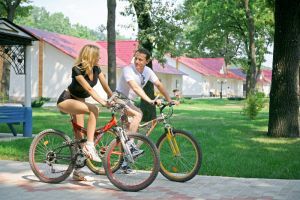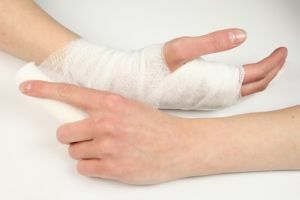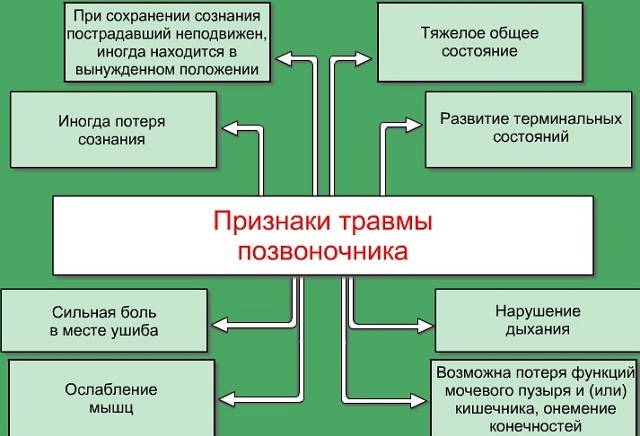 A distinctive feature and superiority of a person from other vertebrate terrestrial creatures is the ability to keep the body in an upright position and the ability to walk. .. on its feet.
A distinctive feature and superiority of a person from other vertebrate terrestrial creatures is the ability to keep the body in an upright position and the ability to walk. .. on its feet.
So the human skeleton is arranged, that for performance of the vital actions limbs are necessary - legs and hands.
In turn, limbs consist of joints, muscles and ligaments.
This article will discuss the problems associated with knee ligaments. So, the knee is an organ that serves as a support and ensures the movement of a person. It is on the share of the knees that a huge load occurs in the performance of certain actions and movements.
The more a particular organ is used and "operated", the higher the risk of injury. The greatest risk is to people who engage in sports or people with certain regular physical activity.
Contents of the article
- Anatomical implication
- Knee ligament functions
- Reasons and mechanism of injury
- What will indicate the stretching?
- How to distinguish from the gap
- Additional methods
- People recommend
- Rehabilitation: long, but possible
- Consequences of injury
- Preventative measures
Anatomical overtones
The knee joint consists of a patellar ligament, a paira cruciform and a lateral ligament, from both lateral surfaces of the leg. It should be noted that all these parts are subject to stretching and tearing.
Sharp movements, lifting of gravity, receiving strokes and dislocations can be the cause of the stretching of ligaments of knee joints.
This is characterized by microscopic tearing of the tendon fibers, in a state of maximum muscle fiber strain of the knee part. In this case, the ligaments lose the property of stretching, which contributes to the occurrence of pain.
To begin with, it is necessary to form a figurative representation of the structure of the knee joint. The damping function of the knee joint is performed by the lateral and medial meniscus, which is located inside the joint itself.
Also, taking into account the fact that the knee takes on various loads, this is ensured by the presence of a large number of ligaments, which in turn are located inside and outside the joint.
Knee ligament functions
Knee joints form the outer ligaments: 
- peroneal collateral ligament;
- tibial collateral ligament;
- oblique popliteal ligament;
- popliteal ligament of an arcuate shape;
- patellar ligament;
- ligaments supporting the patella.
And internal:
- anterior cruciate ligament;
- posterior cruciate ligament.
Bundles perform such functions:
- Collateral tubal ligament and tibial collateral ligament .Support the femoral condyle and tibia together. These ligaments prevent lateral inflexions of the knee joint.
- Knee patch .The binder provides suspension of the calyx, which improves the slip of the condyles of the bone, being expelled by the cartilage along the inner surface.
- Internal and external support patella of the patella .The ligaments perform the function of suspending the calyx.
- The anterior cruciate ligament serves to limit the displacement of the hip bone forward in relation to the shin.
- The posterior cruciate ligament serves as a stabilizing link of the knee joint in preventing hip displacement back against the shin.
Causes and mechanism of injury
Despite the complex and perfect structure of the knee joint in general, it does not protect it from external factors that lead to different types of injuries and diseases.
In most cases, the reason is the usual sports or household effects. The whole point is that a person performs actions that do not correspond to the normal functioning of the ligaments of the knee joint.
For example, sharp jerks among athletes and tennis players, which without a doubt lead to an immediate load on the joint.
The mechanism of the appearance of injuries and stretch marks of the knee joint, is a specific feature.
It is coordinated with force effects like falling, collision, frequent impacts on the knee joints by different weight loads, wrong decisions of the joint itself.
What will indicate the stretching?
 Based on the causes and mechanism of knee injury, the final stage of the process is the manifestation of characteristic signs and symptoms.
Based on the causes and mechanism of knee injury, the final stage of the process is the manifestation of characteristic signs and symptoms.
Most, in the situation of injuries, at the first moment can not be determined, there was a break or stretching.
So, in case of sprain of knee joints, strong, but indeterminate pain is a characteristic feature.
Regarding the uncertainty, it is difficult to determine the exact source of pain when the rupture occurs.
Swelling occurs. If you try to move the knee, it is accompanied by a manifestation of pain, in some cases by the appearance of a crunch and clicks. When a serious injury is received, hemorrhages are recorded.
Also, with a more severe sprain, the signs are accompanied by stiffness or lack of self-motion of the joint.
When attempting to stand on the foot, the foot may be tucked up in the knee area. At the same time, there is a constant and involuntary muscle tension.
Symptoms with sprains are a consequence of irritation of nerve endings, which are compound ligaments, edema and the origin of hemorrhages in the soft tissues of the joint.
At first the pain intensifies only when you try to make movements. In some cases, the movement can be realized at the first time.
After a certain time, the symptoms manifest with an increase in edema, the appearance of pain and restriction on movement.
Degrees of stretching
When traumas and injuries of knee ligaments exist, their characteristic degrees are.
Basically they are displayed in 3 degrees:
- I-degree - easy stretching .In this case, damage to small parts of the ligament is observed. At the same time there is little tangible pain that does not interfere with the movement of a person. The integrity of the ligament can not be disturbed significantly, only the occurrence of micro-ruptures.
- II-degree - moderate stretching , with a partial rupture, taking into account deeper involvement of ligaments. The second degree represents a violation of the ligament, which entails the process of inflammation. The most severe pain is felt, edema and hematoma appear.
- III-degree - severe stretching , accompanied by a complete rupture, with the presence of a deep disruption of the joint. In this case, acute and severe pain occurs. There is a bruise and edema. The consequence of the third degree may be chronic compliance to various and regular injuries.

How to distinguish from the gap
To distinguish the elongation of knee ligaments from their rupture can be not only the presence and level of pain, but also the level of the possibility of performing movements of the injured joint.
In the presence of stretching, a limitation in the mobility of the joint is characteristic.
Diagnostic approach
Reproduction of diagnostics, taking into account the intellectual and technical potential of modern medicine, is not difficult.
If the symptoms are located in the part of getting injured, edema is obvious, the volume is increased, and the skin color has acquired a different color, so the patient expresses the opinion that there is the same pain during movement and inaction, this indicates the presence of stretching.
There are technical possibilities:
- MRI;
- computed tomography;
- ultrasound;
- X-ray;

- arthroscopy.
In this way, you can take corresponding pictures in the appropriate projections. Through this method of diagnosis, you can see the entire structure of the knee joint, taking into account the ligaments, tendons and cartilage.
Through the use of the arthroscopy method, an internal joint examination is performed. This method is also called a small surgical method. The method is used in treatment.
First Aid Assistance
 An important point in stretching knee ligaments is first aid.
An important point in stretching knee ligaments is first aid.
Before, it is necessary to provide immobilization of the victim with the complete exception of unwanted movements. This will prevent further aggravation of the trauma.
You definitely need to wrap a knee with cold material or apply a compress .When there is a strong and increasing pain, you need to take an anesthetic and, of course, immediately call the doctors. Of course, it is advisable not to get into these negative situations and in all possible ways to avoid the possibility of injuries. And for this you need to be more circumspect, cautious and vigilant!
But, since there is a disease, it needs to be treated.
During the treatment period it is desirable to adhere to bed rest without making active movements. Loads on the diseased knee are excluded.
If stretching is accompanied by a joint injury and in the presence of hemarthrosis treatment should be carried out in a stationary mode.
It is recommended to use a tight bandage bandage with bruises without blood clots.
In the case of the appearance of fluid in the joint, it is necessary to perform a fixation with a plaster bandage throughout the ankle joint and thigh. This bandage should be worn until the liquid disappears.
The purpose of these procedures is to strengthen the muscles and fully restore the normal functioning of the joint.
In addition, novocaine injections are made:
- , a novocaine solution is injected into the knee cavity;
- superimpose the gingival laget, which must be fixed for up to 14 days.
This technique is used to a greater extent by athletes.
Additional methods
Ice treatment favorably affects the narrowing of the blood vessels, which helps reduce inflammation.
To do this, enough pieces of ice contained in sachets, wrap in a wet towel and keep on the knee for up to 20 minutes.
The procedure can be applied 3-4 times a day. 
Use of a bandage from an eraser bandage. This ensures adequate protection of the knee joint from unwanted movements.
It is necessary to keep the knee in an elevated position. In a lying position, you need to keep your leg above your chest, which helps reduce swelling.
The use of non-steroidal anti-inflammatory drugs, contribute to the elimination of pain and swelling. The use of thermal procedures also helps to reduce pain.
Procedures are recommended to be applied 3-4 times a day.
The people recommend
In addition to the application of medical procedures for stretching the ligaments of the knee joint, treatment with folk remedies is possible.
It should be noted that a complete cure in this case is almost impossible.
Recommended Ointment Prescriptions for Stretching:
- It is necessary to mix clay with vinegar from apples and apply the obtained ointment to the injured part of the knee, you will get the effect of warming, anesthetizing and relieving inflammation.
- Eucalyptus leaf gruel with rubbed garlic also has a positive effect. To prepare the ointment, grind eucalyptus leaves and mix with rubbed garlic, boil for 5 minutes and apply every day.
- Application of grated, raw potatoes speeds up the recovery process. Mixing mashed potatoes with onion or cabbage enhances the properties of the ointment.
Rehabilitation: long, but possible
The recovery process after an injury may take a long time.
The rehabilitation period can be 2-3 months .It all depends on the level of the injury. It is necessary to begin treatment for primary expressions of the disease.
Given the existence of latent periods of the disease, there is a possibility of an increase in the level of pathology. This also contributes to an increase in treatment time and the process of knee joint recovery. The most important thing is to start treatment in time.
If there is an easy extension, the victim should be kept at rest for several days.
If the injury is more severe, then you need to pay special attention to the rehabilitation process. In this case, the restoration can last up to a month.
 In case of minor injury, it is enough to train on a bicycle. In this case, the knee joint is repeatedly bent and unbent. Training needs to be implemented carefully and gradually build up the workload.
In case of minor injury, it is enough to train on a bicycle. In this case, the knee joint is repeatedly bent and unbent. Training needs to be implemented carefully and gradually build up the workload.
To begin with, the duration of training should not exceed 20 minutes per day.
Extension and flexion of the leg can also be made sitting on a bench. To do this, you just need to lift your legs and keep in the air for 3 seconds.
You can use an "imaginary" bike ride. To do this, you must lie on your back, raise your legs and imitate the ride.
For rehabilitation purposes, methods of therapeutic massage, physiotherapy are used.
Manual actions that improve the blood supply and recovery of the muscular and tendon fibers of the knee joint are applied.
In any case, the assistance of a qualified specialist is needed, since with gradually the level of load and the types of exercises to be performed will vary.
Consequences of injury
The ability to run, jump, crouch, turn and just walk provides the knee joint. It also holds the bones of the thigh and lower leg.
In case of incomplete recovery after an injury, a person will be limited in all these possibilities.
Preventive measures
To prevent injuries to the ligaments of the knee joint is quite simple.
During walking you need to be careful and look under your feet, look at what and how you step.
Given the increased risk in the winter, it is necessary to bypass the frozen and slippery parts of the roads.
Athletes need to perform warm-up and gymnastics.
Just do not forget about regular physical exercises that help strengthen the ligaments.



